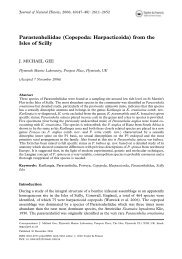An Updated Classification of the Recent Crustacea
An Updated Classification of the Recent Crustacea
An Updated Classification of the Recent Crustacea
Create successful ePaper yourself
Turn your PDF publications into a flip-book with our unique Google optimized e-Paper software.
Thus, he did recognize (temporarily, at various<br />
times) Talitroidea Bulycheva, 1957, Corophioidea<br />
Barnard, 1973, and Haustorioidea Barnard and<br />
Drummond, 1982. Several <strong>of</strong> Jerry’s informal ‘‘anglicized’’<br />
groupings <strong>of</strong> freshwater families (e.g.,<br />
‘‘gammarida,’’ ‘‘crangonyctoids,’’ ‘‘hadzioid<br />
group,’’ etc., in Barnard and Barnard, 1983; Williams<br />
and Barnard, 1988) ra<strong>the</strong>r closely resemble<br />
some <strong>of</strong> <strong>the</strong> superfamilies (and families) formally<br />
named and fully defined previously (1973, 1977,<br />
1979, 1982) by Bousfield and co-workers (e.g.,<br />
about 75% compatibility with Gammaroidea, Hadzioidea,<br />
Crangonyctoidea, Melphidippoidea, etc.).<br />
However, he did not attempt formal phyletic groupings<br />
<strong>of</strong> most marine gammaridean families, nor formal<br />
integration with o<strong>the</strong>r amphipod suborders.<br />
Unlike Sars (1895), Stebbing (1906), and o<strong>the</strong>r<br />
‘‘turn-<strong>of</strong>-<strong>the</strong>-century’’ workers, Jerry apparently did<br />
not recognize <strong>the</strong> significance <strong>of</strong> reproductive form<br />
and behaviour in amphipod phylogeny. Jerry’s final<br />
major work (with Gordan Karaman, 1991, p. 7)<br />
disavowed <strong>the</strong> significance or use <strong>of</strong> <strong>the</strong> formal superfamily<br />
concept, and listed families alphabetically<br />
ra<strong>the</strong>r than phyletically or semi-phyletically (as in<br />
Sars and Stebbing, above). Some classifications are<br />
based on carefully defined characters and character<br />
states that have required (and will continue to require)<br />
modification according to features found in<br />
subsequently discovered species and genera, and<br />
are consistent at proper classificatory levels. The<br />
cladistic arrangement by Kim and Kim (1993), reviewed<br />
ra<strong>the</strong>r unfavourably by Schram (1994), underscores<br />
<strong>the</strong> unreliability <strong>of</strong> cladistic analysis when<br />
care is not taken in <strong>the</strong> appropriate selection and<br />
accurate definition <strong>of</strong> characters and character<br />
states.<br />
[Concerning your statement about Bousfield and<br />
Shih], Bousfield and Shih (1994) represents an updating<br />
and refinement <strong>of</strong> previous 20 years <strong>of</strong><br />
study and publication on gammaridean phylogeny.<br />
[Concerning your statement about Reptantia],<br />
‘‘Natantia’’ and ‘‘Reptantia’’ are terms (names)<br />
pragmatically defined, but not incorporated formally<br />
by Bousfield and Shih (1994). The terms are<br />
analogous to former groupings <strong>of</strong> families and superfamilies,<br />
etc., within <strong>the</strong> Order Decapoda.<br />
[Concerning your statement about names and<br />
dates], omission <strong>of</strong> author names and dates in tabular<br />
listing <strong>of</strong> families and superfamilies is modeled<br />
after similar ‘‘heading’’ omissions in Barnard’s<br />
‘‘Families and Genera . . .‘‘ (1969) and earlier ‘‘Index<br />
. . .’’ (1958). Obviously, <strong>the</strong>se names are fully<br />
treated in <strong>the</strong> major references (e.g., Stebbing,<br />
1906; Gurjanova, 1951; Bousfield 1979, 1982,<br />
l983; Schram, 1986). Readers are expected to provide<br />
something <strong>of</strong> substance to <strong>the</strong> discussion, such<br />
as commentary on <strong>the</strong> paper’s extensive analysis <strong>of</strong><br />
‘‘across-<strong>the</strong>-phyletic-board’’ variability <strong>of</strong> major<br />
characters and character states (antennae to telson)<br />
that would be <strong>of</strong> prime significance in a cladistic<br />
treatment.<br />
[Concerning your statement to <strong>the</strong> effect that we<br />
presented different phylogenetic hypo<strong>the</strong>ses in our<br />
1994 paper], Bousfield and Shih acknowledge<br />
(problems in resolution) that <strong>the</strong>y do not have a<br />
‘‘final answer’’ to <strong>the</strong> probably correct evolutionary<br />
history <strong>of</strong> <strong>the</strong> Amphipoda (only one answer can be<br />
correct!). Their ‘‘semi-phyletic’’ methodology modifies<br />
<strong>the</strong> strictly phenetic format <strong>of</strong> Sneath and Sokal<br />
(1973) by careful ordering <strong>of</strong> character states<br />
to arrive at a ‘‘plesio-apo-morphic index’’ <strong>of</strong> probably<br />
correct phyletic relativity for each taxon. This<br />
approach tends to minimize <strong>the</strong> negative effects <strong>of</strong><br />
homoplasious convergence in many <strong>of</strong> <strong>the</strong>se character<br />
states (analyzed above). Mike Ghiselin (1984)<br />
correctly points out, rigid and uncritical application<br />
<strong>of</strong> cladistic methodology alone quite frequently<br />
leads <strong>the</strong> user to a less-than-credible phylogenetic<br />
result. Thus, use <strong>of</strong> <strong>the</strong> ‘‘Wagner 78’’ cladistic program<br />
<strong>of</strong>ten provides multiple ‘‘trees’’ from <strong>the</strong> same<br />
data base, each one different, each one tending to<br />
invalidate <strong>the</strong> o<strong>the</strong>r, and none probably correct!<br />
[Concerning your statement about cladistic analyses<br />
having high priority], to my knowledge, cladistic<br />
‘‘purists’’ have not yet actually demonstrated<br />
a cladistically derived treatment <strong>of</strong> all 118 gammaridean<br />
families <strong>of</strong> your list. Chances <strong>of</strong> doing so<br />
would appear ‘‘slim-to-non-existent.’’ Instead, advocacy<br />
<strong>of</strong> rDNA methodology would probably result<br />
much sooner in a most-probably-correct answer!<br />
[Concerning your statement that most workers<br />
would prefer to see <strong>the</strong> families listed alphabetically<br />
ra<strong>the</strong>r than by superfamily], how surprising that<br />
such an unsupported statement should come from<br />
Les Watling, a confirmed crustacean phylogenist!<br />
On more serious reflection, Les may find that quite<br />
a few current workers (e.g., Mike Thurston, John<br />
Holsinger) do not ‘‘give up’’ so easily on <strong>the</strong> full<br />
solution <strong>of</strong> this difficult problem.<br />
[Concerning your use <strong>of</strong> <strong>the</strong> word hypo<strong>the</strong>ses],<br />
do you mean ‘‘concepts’’? All family and superfamily<br />
names represent ‘‘concepts’’ <strong>of</strong> presumed natural<br />
groupings <strong>of</strong> species. Some are better defined (in<br />
terms <strong>of</strong> careful definition <strong>of</strong> character states) and<br />
longer time-tested than o<strong>the</strong>rs. Most superfamily<br />
names in Bousfield and Shih (1994) have been carefully<br />
and fully (multiple-character) defined, <strong>the</strong>ir<br />
component families named, and time-tested (by<br />
o<strong>the</strong>r workers as well) over a 15 year period.<br />
Since superfamily taxonomic stability (75%) would<br />
appear at least equal to that <strong>of</strong> <strong>the</strong> component family-level<br />
names <strong>of</strong> <strong>the</strong> current Martin–Davis list, although<br />
both lists are ‘‘conceptual,’’ nei<strong>the</strong>r can realistically<br />
be termed ‘‘hypo<strong>the</strong>tical.’’<br />
Additional References<br />
[Note: Dr. Bousfield did not supply references to all papers<br />
mentioned above.]<br />
Bousfield, E. L. 1995. A contribution to <strong>the</strong> natural classification<br />
<strong>of</strong> Lower and Middle Cambrian arthropods:<br />
food ga<strong>the</strong>ring and feeding mechanisms. Amphipacifica<br />
II(1):3–34.<br />
108 Contributions in Science, Number 39 Appendix I: Comments and Opinions











